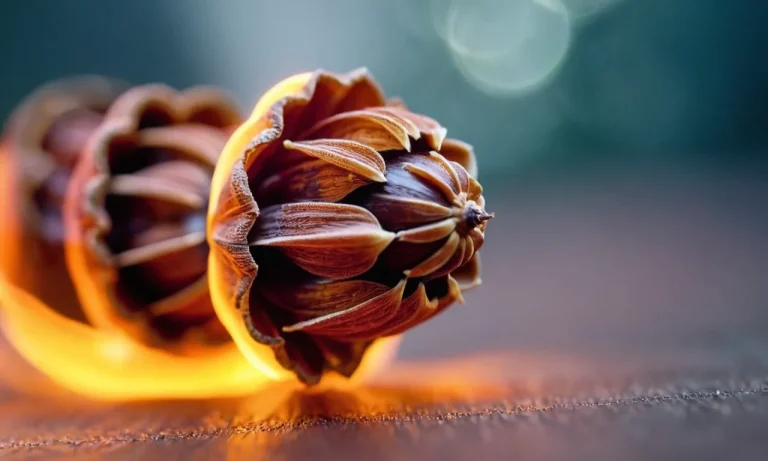Albizia flowers, with their delicate pink and white puffball blooms, have long held symbolic meaning in various cultures and spiritual traditions. If you’ve wondered “what do albizia flowers represent spiritually?” you’ve come to the right place.
In short, albizia flowers symbolize joy, imagination, and new beginnings. Their flowering heralds the start of summer, a time of warmth, growth and emotional openness.
Appearance and History of Albizia Flowers
The Physical Characteristics of Albizia Blossoms
Albizia blossoms are delicate and eye-catching flowers produced by trees in the genus Albizia. There are over 150 different species of Albizia trees, mostly native to tropical and subtropical regions of Asia, Africa, and the Americas.
The blossoms are usually white or pink with fine filaments giving them a soft, fluffy texture. The stamens protrude beyond the petals, looking like silky hairs or feathers. Some species like the pink silk tree (Albizia julibrissin) have flowers arranged in dense clusters on long stems, while others like the rain tree (Albizia saman) have round puffball-shaped flower heads. This unique appearance contributes to the spiritual symbolism associated with Albizia blossoms in various cultures.
Albizia Species and Their Natural Habitats
Common Albizia species valued for their ornamental and ecological benefits include:
- Mimosa/silk tree (Albizia julibrissin) – native to eastern and southeastern Asia
- Rain tree (Albizia saman) – native to Central and South America
- White siris (Albizia lebbeck) – native to tropical southern Asia
- Falcataria (Albizia falcataria) – native to the Moluccas and Sulawesi
These fast-growing trees typically thrive in riparian areas and rainforests. Their nitrogen-fixing roots improve soil fertility, while their expansive canopies provide shade and habitat. The global distribution of iconic Albizia species shows how their captivating flowers have spread beyond indigenous ranges into ornamental gardens worldwide.
Symbolic Meanings in Ancient Cultures and Folklore
Albizia blossoms have long been associated with spiritual concepts like enlightenment, creativity, affection, and new beginnings:
- In Chinese legend, an immortal poet lived in a silk tree (Albizia julibrissin)
- Rain tree (Albizia saman) flowers represent new opportunities in Maya astrology
- Ayurvedic traditions use siris (Albizia lebbeck) flowers to calm the mind
Albizia flowers also signify treasured memories. A common Arabic name for Albizia lebbeck is “girnar” meaning “bride’s flower,” as bridal beds were decorated with its blossoms. In Hawaiian culture, lei necklaces called “pikake” were traditionally strung using falcataria (Albizia falcataria) flowers.
These symbolic meanings reveal why cultures across history have celebrated Albizia trees for their spiritual energy and special charm.
Albizia Flowers Represent Joy and Imagination
Playfulness of the Puffy Blooms
With their fluffy, pink powder puff-like blooms, albizia flowers evoke a sense of playfulness and childlike joy. Their whimsical appearance reminds us to approach life with a spirit of fun and lightheartedness.
As the old saying goes, “We do not stop playing because we grow old; we grow old because we stop playing.”
The albizia tree itself has a drooping, weeping growth habit that gives it an almost whimsical look. Its branches sway gently in the breeze, beckoning us to relax and let our imagination wander. Native to tropical regions, the albizia tree is sometimes called a “vacation tree” or “happiness tree” due to its carefree appearance.
In many cultures, the albizia flower is seen as representing a return to innocence and the freedom of childhood. Its soft, fuzzy blooms call to mind downy baby chick feathers or harmless, floating dandelion puffs.
By inspiring us to embrace play and creativity in our lives, albizia flowers remind us that true wisdom and enlightenment often require childlike openness, awe, and presence.
Childlike Wonder and Creativity
The albizia flower’s association with youthfulness and imaginative freedom make it a natural symbol for the awakening of creativity. Children have a natural talent for original thinking and creative exploration of ideas.
With their minds unclouded by preconceptions, children see the world through fresh eyes.
Albizia’s soft, airy blooms beckon the inner child in all of us to come out and play. They remind us to nurture our sense of wonder, imagination, and possibility. With open and receptive minds, we can tap into boundless creative inspiration.
In magic and spiritual rituals, albizia flowers represent unlocking creative potential and finding imaginative solutions to problems. By returning to a state of childlike curiosity, we open ourselves to creative downloads and “aha moments” of inspiration.
The drooping grace of albizia branches hints that we must let go and surrender logical thinking to tap our wells of creativity. Great achievements often begin by coloring outside the lines of convention.
Just as albizia’s airy seed pods scatter far from the parent tree, inspired ideas can travel to unexpected places when freed from preconceived constraints.
So the next time you admire albizia’s carefree puffs of blushing pink, allow your inner child to come out and play. Open your mind to imaginative adventures, and you may be delighted by the creative ideas that bloom.
Albizia Blossoms Herald New Beginnings
Flowering Marks the Start of Summer
When albizia trees erupt into fluffy pink flower clusters in early summer, it’s a sign that the new season has officially begun. These fast-growing trees are often planted for their decorative blossoms, which emerge right around the summer solstice in late June and fill the air with a sweet, honey-like scent.
In many cultures, the summer solstice marks a time of renewal, when the days begin growing longer and the sun’s power builds. For ancient pagan groups, this seasonal shift was connected to fertility, harvests, and the great goddesses of the earth.
Albizia’s vibrant blooms fit nicely with these cosmic themes of rebirth and new vitality.
Connections to Graduations and Other Transitions
Beyond the seasonal associations, albizia flowers also symbolize fresh starts in general. Their appearance coincides with graduation season in many parts of the world. The trees bloom right around the time when students complete their academic journeys and embark on new phases of life.
The parallels don’t end there. Albizia trees grow rapidly, adding several feet of height each year. Their flowering cycles mirror our own developmental timelines, with new blossoms emerging regularly as the trees mature.
The flowers represent our capacity for continued growth and self-actualization at any stage of life.
Here are some key symbolic meanings associated with albizia blossoms:
- New beginnings
- Achievement
- Personal expansion
- Hope and optimism
- Endurance
So the next time you spot these delicate pink pom-poms, take a moment to reflect on new horizons ahead. The albizia invites us to commemorate our passages from one chapter to the next.
Using Albizia Flowers for Meditation and Rituals
Albizia flowers have long been used in spiritual practices for their uplifting energies. With their delicate pink and white coloring, albizia blooms are believed to impart a sense of peace, calm, and inner reflection (source).
Here are some of the main ways these symbolic flowers can enhance meditation and rituals.
Promoting a Meditative State
The sweet fragrance and visual beauty of albizia flowers are said to quiet the mind and open it up to receiving wisdom and guidance (source). Having a vase of fresh-cut blooms or sipping albizia flower tea can help relax the body and settle scattered thoughts during meditation.
Some spiritual practitioners also burn dried albizia flowers or essential oils as incense to produce a calming environment for reflection and awareness. The floral smoke carries the energy of stillness, presence, and insight (source).
Adding albizia petals to bathwater or burning albizia incense before rituals can also help purify and bless a space.
Strengthening Intentions and Visualization
The meaning behind albizia’s pink and white color symbolism resonates with focusing one’s purpose and vision. The vibrant pink represents joy, affection, and new beginnings, while the clean white signals clarity, spirituality and fresh starts (source).
Holding an albizia bloom during manifestation exercises can amplify the intention being set. Visualizing white and pink light filling one’s mind while meditating with albizia can also boost conscious expansion and creativity.
Some rituals incorporate albizia blooms in altar decorations or use albizia wood to craft special wands imbued with visionary energy. Burning dried albizia flowers as incense during rituals provides supportive and purifying vibrations as well.
Accessing Higher States of Consciousness
Certain mystical traditions recognize albizia flowers as “spirit blooms” holding enlightening frequencies. Meditating with the essence of albizia flowers is believed to open pathways to elevated states of awareness and uncover inner truths (source).
Drinking albizia tea, inhaling the incense smoke or anointing the third eye with albizia essential oil during transcendent practices can act like a “spiritual key” unlocking doorways to cosmic understanding.
Adding albizia petals to dream pillows also promotes vivid, insightful dreams with possible mystical overtones.
With their graceful beauty and significant symbolism, albizia’s cheerful blooms indeed seem invested with inspiring and visionary attributes for meditation, rituals and conscious unfoldment.
Caring for Albizia Plants
Albizia, also known as silk trees, are stunning ornamental trees known for their fluffy pink flowers resembling pom poms. Caring for these mystical trees with spiritual symbolism is relatively easy given their hardy nature. Here are some key tips for keeping your Albizia tree happy and healthy:
Sun and Soil
Albizia trees thrive in full sun, needing at least 6 hours of direct sunlight per day. They prefer moist, well-drained soil that is slightly acidic to neutral in pH. Amend clay soils with compost or other organic material to improve drainage.
One of the most common issues is overwatering, which can lead to root rot, so allow the soil to partially dry out between waterings.
Pruning
Prune Albizia trees in early spring before the leaves emerge. This prevents excessive bleeding from pruning wounds. Remove any dead, damaged or crossing branches using clean, sterilized pruners. You can also do some shaping by shortening overly long branches.
Avoid heavy pruning, which can stress the tree. According to the AgriFarming site, pruning improves airflow and light penetration, enhancing flowering and fruit production.
Fertilization
Apply a balanced granular fertilizer or compost around the base of Albizia trees in early spring. This gives them nutrients right before their main growth period. Organic options like compost or manure release nutrients slowly. An organic mulch can also enrich the soil.
Avoid high-nitrogen fertilizers, which mainly promote leafy growth over flowers. Monitor your tree to assess if additional applications are needed later in summer.
Pest and Disease Control
Fortunately, Albizia trees are relatively pest and disease resistant compared to other ornamentals. However, they can still be impacted by issues like leaf spot, powdery mildew, stem canker, and verticillium wilt.
Pruning out infected parts, improving air circulation, and watering at the base can help prevent problems. You may need to treat with an appropriate organic or chemical fungicide or bactericide if diseases develop. Common insect pests to monitor for include aphids, borers, and scale.
Winter Care
One downside of Albizia trees is that they cannot withstand heavy frost or freezing temperatures. In temperate climates, they will die back to the ground in winter. Cut back frost-killed stems in spring after new growth emerges.
You can also grow Albizia in a container that can be brought indoors or sheltered in a garage or greenhouse over winter. Ensure they receive adequate sunlight from a sunny window or grow lights when kept indoors.
By providing plenty of sun, well-drained soil, occasional fertilization, and pruning, Albizia trees are sure to grow into their full lush, flowering potential. Pay attention for any pest or disease issues and be prepared to overwinter containerized plants.
With the right care, you’ll enjoy these mesmerizing trees and their uplifting spiritual symbolism for years to come.
Conclusion
With their joyful energy and summery blooming period, albizia blossoms beautifully represent optimism, childlike imagination and fresh starts. Incorporating the flowers into spiritual practices can help amplify these uplifting qualities as you embark on new chapters.
If you found this overview on albizia flower meanings interesting or useful, remember to bookmark our site. We regularly publish in-depth articles exploring the symbolism and spiritual attributes of botanicals and other natural elements.






